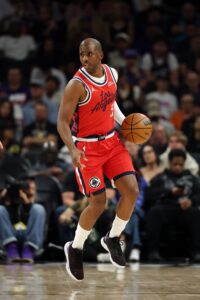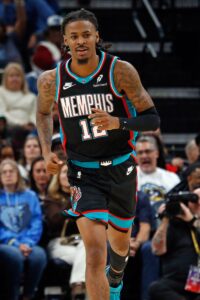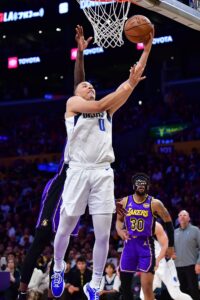As teams around the NBA weigh potential trades or signings that would add a maximum-salary (or near-max) veteran to their roster, they’ve become increasingly wary of navigating the tax aprons, as well as maintaining enough flexibility to build a deep roster, according to executives who spoke to ESPN’s Brian Windhorst and Tim Bontemps.
 “There are two major shifts happening,” a Western Conference general manager explained to Windhorst. “We have everyone being very mindful of the aprons and carefully slotting their players to fit. Then you have the nature of the game, where you need deep rosters to play this volume of games at the speed the league is playing.”
“There are two major shifts happening,” a Western Conference general manager explained to Windhorst. “We have everyone being very mindful of the aprons and carefully slotting their players to fit. Then you have the nature of the game, where you need deep rosters to play this volume of games at the speed the league is playing.”
Stars are still considered vital to building a championship-caliber roster, Windhorst writes, but front offices are more concerned than ever about the potential availability of a player who will be earning upwards of 30-35% of the salary cap, as well as the cost of acquiring and retaining that player, in terms of either salary, draft picks, or both.
“The max-level guys who make tons of money can’t play as many minutes as they could before, so they become less valuable,” an Eastern Conference executive told Bontemps. “You can’t be committing that much of your money to guys who won’t play at all or cannot sustain the same number of games and minutes.”
“You just can’t paper over a guy on your roster that isn’t delivering value at the highest levels,” another Eastern exec added, per Bontemps. “You can manage missing the lower-end guys, but the long-term salaries making $30, $40, $50 million? There’s no getting over that. Those guys bury you in this system.”
Windhorst recently broached this topic in an episode of The Hoop Collective podcast, expressing some skepticism that there will be teams willing to make massive offers for Bucks forward Giannis Antetokounmpo. However, in today’s ESPN article, Windhorst acknowledges that Antetokounmpo – a two-time MVP who is on the wrong side of 30, is on a super-max contract, and will likely warrant another huge extension in the near future – is among the potential exceptions, writing that the “old rules” still apply to a player of that caliber.
“I don’t think you’d see 29 teams make an offer like if, say, Victor (Wembanyama) was available, but there would be plenty of interest (in Antetokounmpo) and probably two to three teams would be willing to go all-in right now,” an East executive told ESPN. “Every player has risk, and he’d have some risk, but this is one you don’t have to work too hard to talk yourself into.”
Conversely, Mavericks big man Anthony Davis, whose 2025/26 salary is identical to Antetokounmpo’s and who is a year-and-a-half older, is the sort of player whose market would be less robust due to concerns about his availability and the percentage of a team’s cap he’d take up, says Bontemps.
“For a guy like Anthony Davis,” a Western Conference executive said, “it’s hard to justify them getting a 35 percent max when they aren’t playing a ton of minutes and games.”
Execs around the NBA may view Philadelphia as a cautionary tale. The Sixers are paying Joel Embiid and Paul George a combined $107MM this season — they’ve appeared in nine and eight games, respectively, and haven’t performed at their usual level.
Bontemps also points to Kings center Domantas Sabonis, Grizzlies forward Jaren Jackson Jr., and Jazz forward Lauri Markkanen as examples of players whose recent pay raises might make some teams less inclined to give up significant hauls for them if they were available. Sabonis will make $94MM in the two seasons after this one; Jackson has a four-year, $205MM extension starting in 2026; and Markkanen will make nearly $50MM annually through 2028/29.
“On their last contracts, they had good value,” an executive said of that trio. “(Now) they are all at a whole new threshold, where you look at them totally differently.”
While front offices may be proceeding with an abundance of caution on certain trade targets, that doesn’t mean that every star who ends up on the trade block will be available at a discount. Even for players with red flags, there could always be one team willing to make a more aggressive offer than what 28 others would consider rational. Still, Windhorst and Bontemps suggest this evolving league-wide sentiment is a factor that could impact the NBA’s trade market going forward.
“The aprons are causing people to think and act differently,” a scout told ESPN. “But there will always be teams that decide to strike while the irons are hot. … It’s an even bigger risk-reward calculation than it has ever been.”

 However, it also includes some players whose names have already popped up in trade speculation in the months since they were signed. The most obvious name in that group is Clippers point guard
However, it also includes some players whose names have already popped up in trade speculation in the months since they were signed. The most obvious name in that group is Clippers point guard  11:32 am: Grizzlies point guard
11:32 am: Grizzlies point guard  November 20:
November 20:  “There are two major shifts happening,” a Western Conference general manager explained to Windhorst. “We have everyone being very mindful of the aprons and carefully slotting their players to fit. Then you have the nature of the game, where you need deep rosters to play this volume of games at the speed the league is playing.”
“There are two major shifts happening,” a Western Conference general manager explained to Windhorst. “We have everyone being very mindful of the aprons and carefully slotting their players to fit. Then you have the nature of the game, where you need deep rosters to play this volume of games at the speed the league is playing.”